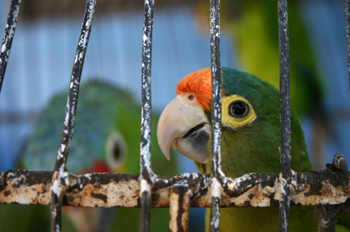General Bird Care Tips
Owning a bird can be an extremely rewarding experience. There are keys to a successful relationship that, if followed properly, allow for a mutually beneficial companionship that can last for decades. Birds have particular needs that must be met in order for them to remain happy and healthy. An extremely important need is housing. Here are some guidelines to follow when thinking about how to house your bird properly.
While caging your bird in the house may at first seem cruel, consider the surroundings. Pet birds may be allowed to remain on perches while you are home to supervise their activity, but they should be confined to cages while you are away to avoid accidental injury and other potential mishaps. Trouble is very often the result of unsupervised birds. Not only can your bird be terribly destructive to your belongings (furniture, decorations, etc.), but all homes contain objects that can be both directly and indirectly harmful to birds. Mirrors, windows, walls, house plants, electrical cords and items containing harmful chemicals are all general hazards. Birds resting on perches are usually happy to stick around; however, if frightened by a loud noise or sudden movement, these unexpected flights can cause your bird to crash into a wall, door, window or mirror because of its confusion.

Helpful Bird Care Information
- The major source of poisoning of pet birds is lead. Found in random places (curtain weights and/or pulls, leaded and stained glass, fishing sinkers, ammunition, costume jewelry), many caged birds seem to have an affinity for this soft metal and love to chew on it. Unfortunately, even a small amount can lead to poisoning, if ingested. Lead poisoning can be successfully treated if diagnosed early enough.
- Caged birds allowed unrestricted freedom in the home may eat house plants or chew on electrical cords, resulting in illness and injury. Some unsupervised pet birds chew on or swallow macrame, carpet, and other similar fabrics, resulting in crop and intestinal impaction.
- Free-flying birds are vulnerable to injury from ceiling fans and hot stoves, as well as attacks by pet dogs, cats and ferrets sharing the same household. It is wise not to underestimate the aggressiveness of our four-legged friends and to restrict contact between them and pet birds as much as possible.
- Birds allowed unrestricted freedom and flight within the home may escape through open doors and windows. Most bird owners have the mistaken notion that their bird would never fly away and leave them. Unfortunately, birds that have escaped the owner's home become disoriented easily when outdoors. This confusion makes return or capture of the escaped bird very unlikely.
- The location of the cage and/or perch in the home is important. Some birds thrive in areas of heavy traffic where they receive lots of attention and are part of the action. Others seem to prefer more privacy and solitude. A pet bird should never be kept in the kitchen. In addition to the obvious gas fumes and occasional smoke from cooking food, there is another, much more dangerous, threat to birds in the kitchen. Super-heated Teflon, and related brand-name non-stick pan coatings, emits fumes that are deadly to all birds. This "accident" happens most often when someone inadvertently leaves a pan coated with a non-stick surface on a lighted gas or electric range burner. The pan becomes hot and the non-stick coating overheats, emitting toxic fumes. Birds that inhale these fumes die quickly.
- Free-flying birds tend to assume a more dominant posture in their relationship with people, and often become intolerably aggressive.
- Contrary to popular opinion, drafts are not harmful to healthy pet birds. A draft is really nothing more than a slight movement of air, usually accompanied by a mild temperature drop. A bird's feathers provide insulation against temperature extremes far in excess of what a draft represents. Drafts are usually inconsequential to pet birds. The notable exception to this is the cool and sometimes cold air produced by air conditioners. Most caged birds cannot tolerate the rapid temperature extremes produced by thermostatically controlled air conditioners. For this reason, cages and perches should not be positioned directly beside or beneath air conditioning, heating or ventilation outflows. Sick birds should always be removed from drafty circumstances to prevent heat loss.
- Covering the bird's cage at night is open to question. Because of the tremendous insulating capacity of feathers, covering a bird's cage at night may not be necessary to protect the bird from cool drafts at night, when the thermostat is usually turned down. The one exception to this would be chilly nights in colder climates. A benefit of covering your bird's cage at night is that it provides a regular period of privacy not usually allowed during the day. Further, it tends to keep the bird quiet in the early morning when it would otherwise become active and vocal. If you now cover your bird's cage at night, continue to do so. If you have not done so in the past and find that your pet bird panics or acts agitated with a cover over its cage, there is no need to continue doing so.
- The most obvious consideration when selecting a cage is the size of the bird. A factor that often gets overlooked when looking at cages is that these cages will be occupied not only by the bird but also food bowls, perches, toys and whatever else the owner chooses. These objects, while absolutely necessary, dramatically cut down the amount of open space in the cage. Another important determinant is the bird's activity level. You will notice some discrepancies between birds and the size of the cage required. Round cages should not be used. They do not give your pet a point of reference and can lead to psychological problems.
[ Search Articles ] [ Article Index ]
